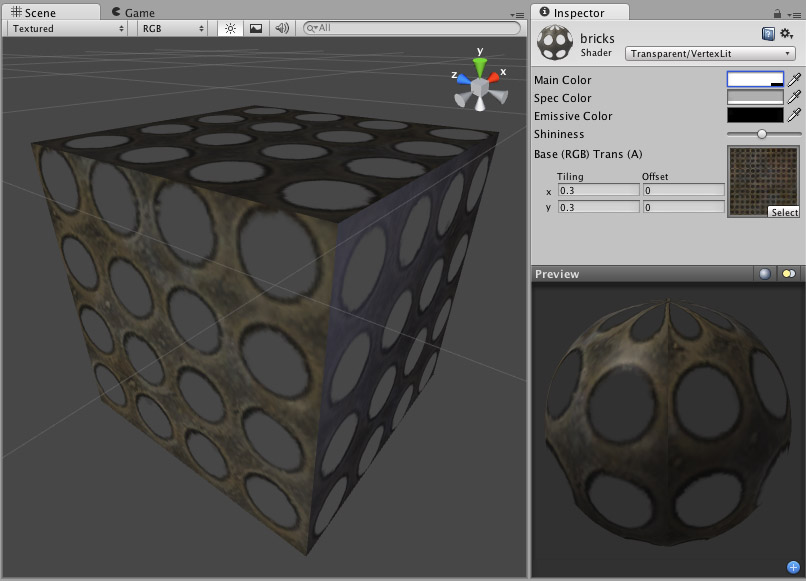Transparent Vertex-Lit
Note. Unity 5 introduced the Standard ShaderA built-in shader for rendering real-world objects such as stone, wood, glass, plastic and metal. Supports a wide range of shader types and combinations. More info
See in Glossary which replaces this shaderA small script that contains the mathematical calculations and algorithms for calculating the Color of each pixel rendered, based on the lighting input and the Material configuration. More info
See in Glossary.

Transparent Properties
Note. Unity 5 introduced the Standard Shader which replaces this shader.
This shader can make meshThe main graphics primitive of Unity. Meshes make up a large part of your 3D worlds. Unity supports triangulated or Quadrangulated polygon meshes. Nurbs, Nurms, Subdiv surfaces must be converted to polygons. More info
See in Glossary geometry partially or fully transparent by reading the alpha channel of the main texture. In the alpha, 0 (black) is completely transparent while 255 (white) is completely opaque. If your main texture does not have an alpha channel, the object will appear completely opaque.
Using transparent objects in your game can be tricky, as there are traditional graphical programming problems that can present sorting issues in your game. For example, if you see odd results when looking through two windows at once, you’re experiencing the classical problem with using transparency. The general rule is to be aware that there are some cases in which one transparent object may be drawn in front of another in an unusual way, especially if the objects are intersecting, enclose each other or are of very different sizes. For this reason, you should use transparent objects if you need them, and try not to let them become excessive. You should also make your designer(s) aware that such sorting problems can occur, and have them prepare to change some design to work around these issues.
Vertex-Lit Properties
Note. Unity 5 introduced the Standard Shader which replaces this shader.
This shader is Vertex-Lit, which is one of the simplest shaders. All lights shining on it are rendered in a single pass and calculated at vertices only.
Because it is vertex-lit, it won’t display any pixel-based renderingThe process of drawing graphics to the screen (or to a render texture). By default, the main camera in Unity renders its view to the screen. More info
See in Glossary effects, such as light cookies, normal mapping, or shadows. This shader is also much more sensitive to tesselation of the models. If you put a point light very close to a cube using this shader, the light will only be calculated at the corners. Pixel-lit shaders are much more effective at creating a nice round highlight, independent of tesselation. If that’s an effect you want, you may consider using a pixel-lit shader or increase tesselation of the objects instead.
Performance
Generally, this shader is very cheap to render. For more details, please view the Shader Peformance page.